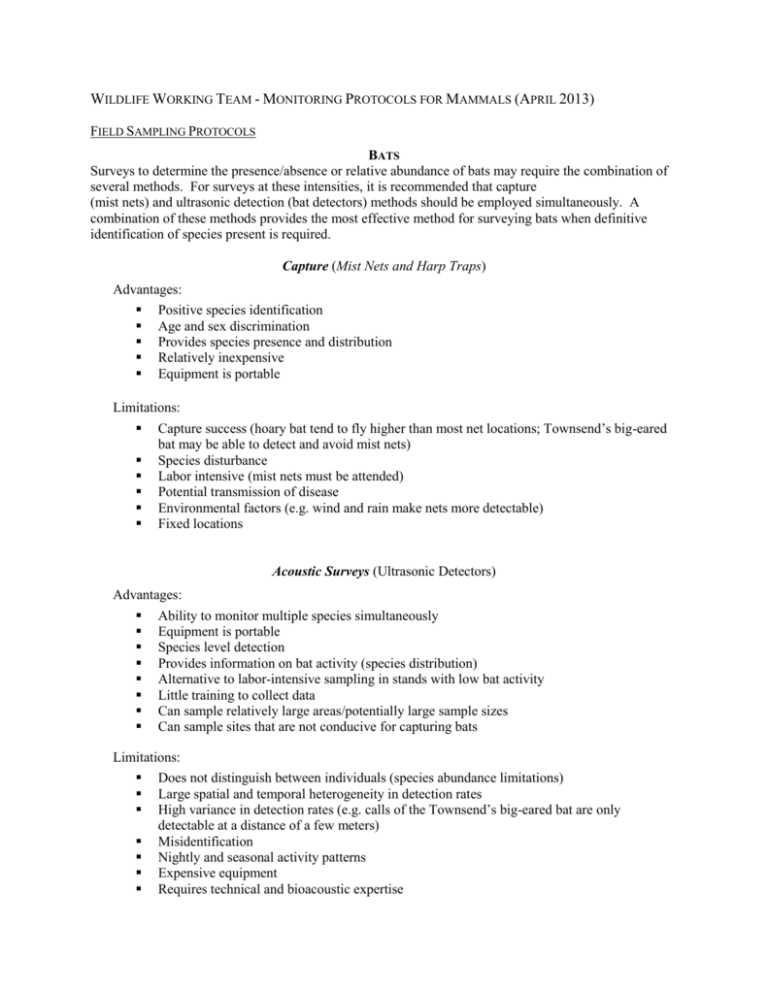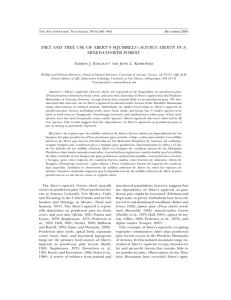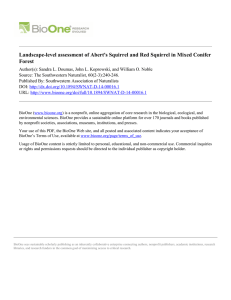Monitoring protocols for mammals (draft)
advertisement

WILDLIFE WORKING TEAM - MONITORING PROTOCOLS FOR MAMMALS (APRIL 2013) FIELD SAMPLING PROTOCOLS BATS Surveys to determine the presence/absence or relative abundance of bats may require the combination of several methods. For surveys at these intensities, it is recommended that capture (mist nets) and ultrasonic detection (bat detectors) methods should be employed simultaneously. A combination of these methods provides the most effective method for surveying bats when definitive identification of species present is required. Capture (Mist Nets and Harp Traps) Advantages: Positive species identification Age and sex discrimination Provides species presence and distribution Relatively inexpensive Equipment is portable Limitations: Capture success (hoary bat tend to fly higher than most net locations; Townsend’s big-eared bat may be able to detect and avoid mist nets) Species disturbance Labor intensive (mist nets must be attended) Potential transmission of disease Environmental factors (e.g. wind and rain make nets more detectable) Fixed locations Acoustic Surveys (Ultrasonic Detectors) Advantages: Ability to monitor multiple species simultaneously Equipment is portable Species level detection Provides information on bat activity (species distribution) Alternative to labor-intensive sampling in stands with low bat activity Little training to collect data Can sample relatively large areas/potentially large sample sizes Can sample sites that are not conducive for capturing bats Limitations: Does not distinguish between individuals (species abundance limitations) Large spatial and temporal heterogeneity in detection rates High variance in detection rates (e.g. calls of the Townsend’s big-eared bat are only detectable at a distance of a few meters) Misidentification Nightly and seasonal activity patterns Expensive equipment Requires technical and bioacoustic expertise Available Protocols/Methods: Vonhoff, M. 2002. Handbook of inventory methods and standard protocols for surveying bats in Alberta. Alberta Environment, Fisheries and Wildlife Management Division, Edmonton, Alberta. 58 pp. Available: <http://wbwg.org/conservation/papers/ABProtocolrevisedMay05.pdf> MELP (Ministry of Environment, Lands and Parks Resources Inventory Branch). 1998. Inventory Methods for Bats. Standards for Components of British Columbia’s Biodiversity No. 20. Resources Inventory Committee. 51 pp. Available: <http://www.ilmb.gov.bc.ca/risc/pubs/tebiodiv/bats/assets/bats.pdf> Manley, P.N.; Van Horne, B.; Roth, J.K.; Zielinski, W.J.; McKenzie, M.M.; Weller, T.J.; Weckerly, F.W.; Vojta, C. 2006. Chapter 7. Bat Monitoring. Multiple species inventory and monitoring technical guide. Gen. Tech. Rep. WO 73. Washington, DC: U.S. Department of Agriculture, Forest Service, Washington Office. 204 p. Available: <http://www.fs.fed.us/rm/pubs_other/wo_gtr073.pdf> Available Data/Monitoring (Potential data and information sources): Colorado Bat Working Group Bats/Inactive Mines Project Bat Trend Survey (The Colorado Bat Society) Colorado Natural Heritage Program Dr. Rick Adams - University of Northern Colorado ABERT’S SQUIRREL Abert’s squirrel is ecologically dependent on ponderosa pine for both nesting sites and food. This species is particularly sensitive to habitat changes in climax ponderosa pine ecosystems. Abert’s squirrel density can be sampled using methods developed by Dodd et al. (1998). This monitoring technique provides an indirect population index based on sign consisting of the remains of over-winter feeding activity and has been demonstrated to be a reliable, consistent, efficient, and cost-effective. Feeding Sign Plots This technique entails the recording of sign of Abert’s squirrel over-winter feeding activity from within established monitoring plots. Feeding sign consists of clipped terminal ends of ponderosa pine limbs, peeled twigs, cone cores, staminate cones, flowers, and apical buds, and hypogeous fungi digs. Advantages: Species occurrence and density Cost-effective Minimal disturbance to species Minimal personnel required Limitations: Environmental factors (particularly drought that affects the availability of ponderosa pine cones and hypogeous fungi) Variable squirrel use of twigs with the availability of other foods Consistency in feeding sign identification (ability of personnel to accurately identify overwinter feeding sign) Method does not account for changes in squirrel abundance due to other factors, such as winter mortality and reproductive failure Available Protocols/Methods: Dodd, N. L. Undated. Guideline for applying a tassel-eared squirrel feeding sign index to estimate spring density. Arizona Game and Fish, Pinetop, Arizona. Dodd, N.L., S.S. Rosenstock, C.R. Miller, and R.E. Schweinsburg. 1998. Tassel-eared squirrel population dynamics in Arizona: index techniques and relationships to habitat condition. Arizona Game and Fish Department, Research Branch Technical Report, 27:1-49. Frey, J.K. 2004. Abert’s squirrel (Sciurus aberti) monitoring and habitat analysis on Carson National Forest, New Mexico, 2004. Final Report submitted to Carson National Forest, 21 pp. Available: <http://www.fs.usda.gov/Internet/FSE_DOCUMENTS/fsbdev7_011779.pdf> Frey, J.K. 2006. Abert’s squirrel (Sciurus aberti) monitoring on Carson National Forest, New Mexico, 2006. Final Report submitted to Carson National Forest, 41 pp. <http://www.fs.usda.gov/Internet/FSE_DOCUMENTS/fsbdev7_011892.pdf> Worden, J.K. and C. Kleier. 2009. Impact of ponderosa pine thinning on Abert’s squirrel (Scuirus aberti) populations on Heil Valley Ranch. Submitted to: Small Grants Program 2009, Boulder County Parks and Open Space, Longmont, Colorado. 18 pp. Avaiable: <http://www.frontrangeroundtable.org/uploads/Roundtable_LR_WWT_042313_Abert_s_at_Heil _Valley.pdf> PSICC. 2004. Abert’s Squirrel Population Trend Monitoring Protocol. Pike and San Isabel National Forests. Rasmussen, D.I., D.E. Brown, and D. Jones. 1975. Use of ponderosa pine by tassel-eared squirrels and a key to determine evidence of their use from that of red squirrels and porcupines. Arizona Game and Fish Department Wildlife Digest 10: 1-12. Available Data/Monitoring (Potential data sources): Monitoring data collected annually since 2006 from 38 plots on the Pike and San Isabel National Forests. Examples of Abert’s squirrel monitoring conducted on the Carson and San Juan Nationals Forests and the Heil Valley Ranch (Boulder County, Colorado).











